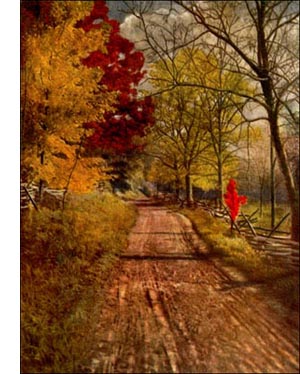Ailanthus Tree
 The Ailanthus (Ailanthus glandulosa, Desf.) is an immigrant from China which has sprung into popularity as a city street tree. A Long Island nurseryman introduced the tree in 1820. New York City and Brooklyn planted the saplings extensively Smoke and dust do not seem to injure their great, fern-like leaves, They throve in sterile and worn-out soil, shading hot pavements and clothing waste places with verdure.
The Ailanthus (Ailanthus glandulosa, Desf.) is an immigrant from China which has sprung into popularity as a city street tree. A Long Island nurseryman introduced the tree in 1820. New York City and Brooklyn planted the saplings extensively Smoke and dust do not seem to injure their great, fern-like leaves, They throve in sterile and worn-out soil, shading hot pavements and clothing waste places with verdure.Then came the blossoming, and the inch worm! The staminate trees had a rank odour, and the pollen annoyed people with catarrh. Caterpillars revelled on the luxuriant foliage, and dropped upon passersby. A tide of feeling against these trees swept the cities. An effort was made to get rid of them. But no such effort can be made unanimous. The caterpillar nuisance was soon controlled by the birds. It was found that only staminate trees are malodorous, and the blossoming period is soon over.
Pistillate trees can be guaranteed to planters by taking cuttings for nursery stock from pistillate trees only. The ailanthus is now rated at its real value. It is certainly a luxuriant tree and especially adapted for city planting. The dead, stiff appearance of the tree in winter is forgiven when spring sets the sap astir once more.
Ailanthus leaflets are plain margined except for a tooth or two near the base. The long leaves resemble those of the sumachs. The opening leaves and later the ripening fruit clusters exhibit most beautiful variations of rich colour-pinks, reds and bronzes. Somebody is sure to harbour a seedling tree whose pollen fertilises the pistillate flowers of a whole neighbourhood. A fruiting tree in late summer looks like a great hydrangea.
The vigour of ailanthus seedlings is amazing. Suckers ten feet high shoot up in one season. They appear in the most unexpected places. The tilting rafts on which the seeds are borne carry them with the wind, and lusty young trees come up in crannies of city back yards, covering unsightly objects with their graceful plumes of green. I have seen seedlings throw up leafy shoots 8 feet long and an inch through, bearing leaves nearly a yard long-all in one season. But these are youngsters, growing in exceptionally rich soil. Such lusty growers are peculiarly subject to accidents. The wind breaks off limbs, and the trunks become riddled with decay.
Short-lived as ailanthus trees are, they soon replace themselves. Their popularity is not likely to decline. The traveller in Europe will find them in evidence in the parks and along the boulevards of Paris and other cities. In Peking they are favourite shade and ornamental trees, for the ailanthus is the Chinaman's "Tree of Heaven."
An effective use of the ailanthus is to plant a few seeds along a fence or boundary line. Cut back the young trees to a few feet high each spring, and a beautiful leafy screen will result.